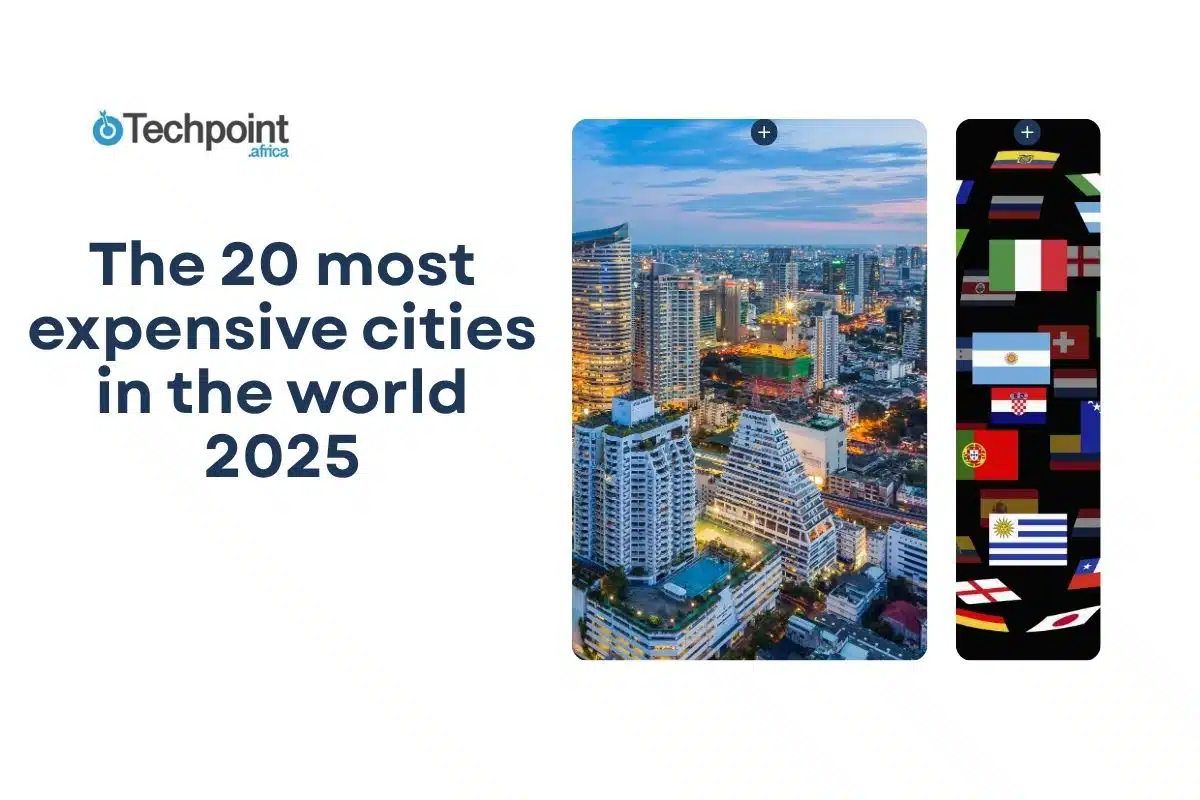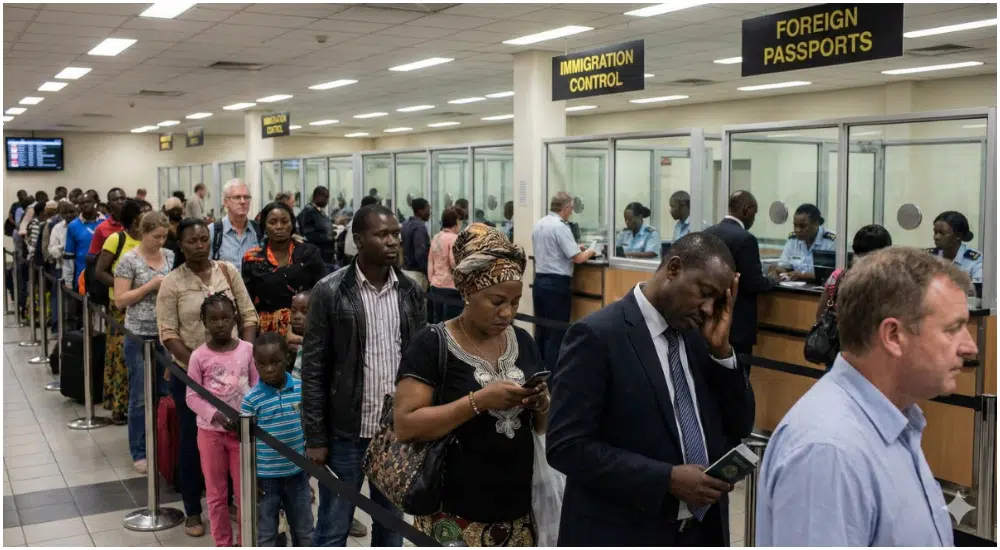Some cities demand more from your wallet than others. Rent is steep. Groceries aren’t cheap. And everyday expenses quietly stack up until living comfortably starts to feel like a luxury.
But why? What makes life in these places so expensive?
To answer that, we’re looking at rankings from the Economist Intelligence Unit (EIU) and Mercer’s 2024 Cost of Living reports, two of the most trusted sources for measuring global living expenses. The cities on this list stand out not just for high prices, but for how consistently those prices show up across rent, transport, food, and services. And in each city, it adds up differently.
If you’re thinking of relocating, comparing your current city, or just curious where money stretches the least, this guide puts things in perspective.
Let’s get into it.
1. Singapore, Singapore
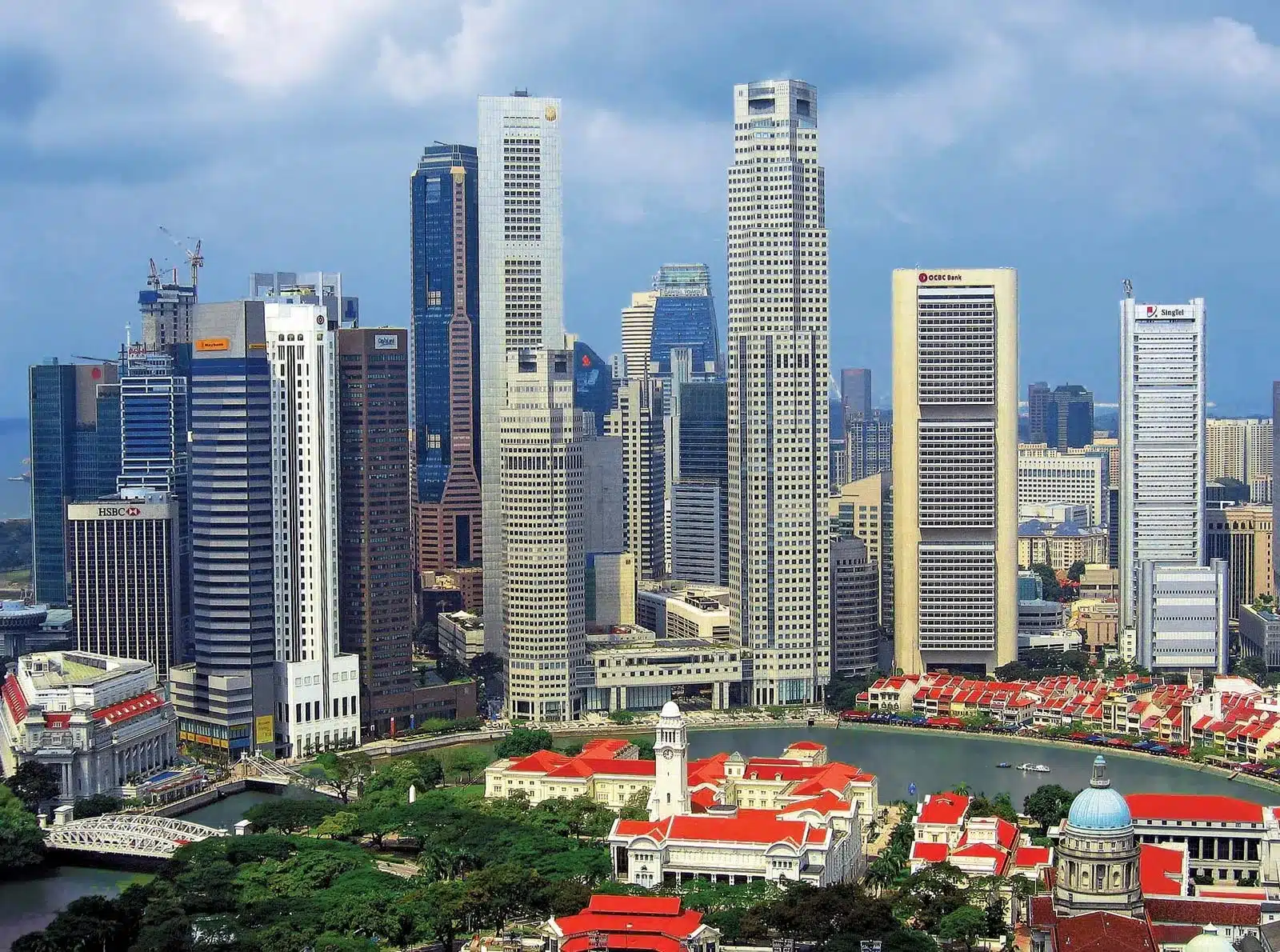
Singapore doesn’t just top cost-of-living rankings, it stays there, year after year. The city’s reputation for safety, order, and efficiency comes at a price, and that price touches almost every aspect of daily life. From housing to transportation, nearly everything costs more here. It’s clean, it’s smart, it works, but it’s not cheap.
Average Monthly Rent
- 1-bedroom in the city centre: $3,000 – $4,500
- Family apartment: $6,000+
Space is limited, so property is gold. Rent remains one of the biggest expenses, especially in well-connected or expat-friendly neighbourhoods.
What Drives the Cost
- Housing scarcity: Limited land plus high demand keeps prices up. Even public housing (HDBs) can be competitive.
- Car ownership: A modest car can cost over $100,000, largely due to the Certificate of Entitlement (COE).
- Imported essentials: Nearly all food and household items are imported, so even groceries add up fast.
- Tax on lifestyle: Alcohol, cigarettes, and even cars are heavily taxed.
Life in Singapore
Day-to-day life is smooth. Public transport is reliable. Healthcare is excellent. The city is spotless and incredibly safe. But between high rents, pricey schools, and steep leisure costs, you’ll feel the pressure unless your income rises to meet it.
2. Zurich, Switzerland
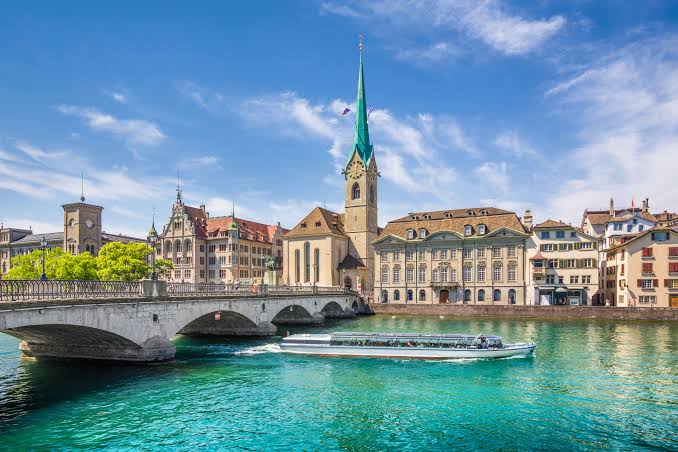
Zurich is often seen as polished, peaceful, and prosperous and that prosperity comes at a cost. It’s one of Europe’s financial powerhouses, home to major banks, luxury boutiques, and a high standard of living. But for residents and newcomers, it’s also one of the most expensive cities to maintain even a modest lifestyle.
Average Monthly Rent
- 1-bedroom in the city centre: $2,500 – $3,800
- 3-bedroom apartment: $4,500 – $6,000+
Housing is well-regulated and high-quality, but availability is tight and demand drives up prices — especially near the lake or financial districts.
What Drives the Cost
- High wages, high prices: Zurich residents earn well, but services and goods are priced accordingly.
- Dining and groceries: A simple meal out can cost $25–$40 per person. Grocery prices are high, especially for meat and packaged foods.
- Healthcare and insurance: Switzerland’s private insurance system adds to the cost of living, even with employer support.
- Transport: Efficient, but not cheap. A monthly transport pass runs about $90–$110.
Life in Zurich
Everything runs like clockwork — public services, healthcare, education, and infrastructure are all excellent. Nature is close, the city is safe, and quality of life is high. But even a comfortable life here requires a healthy income, careful budgeting, or both.
3. Geneva, Switzerland
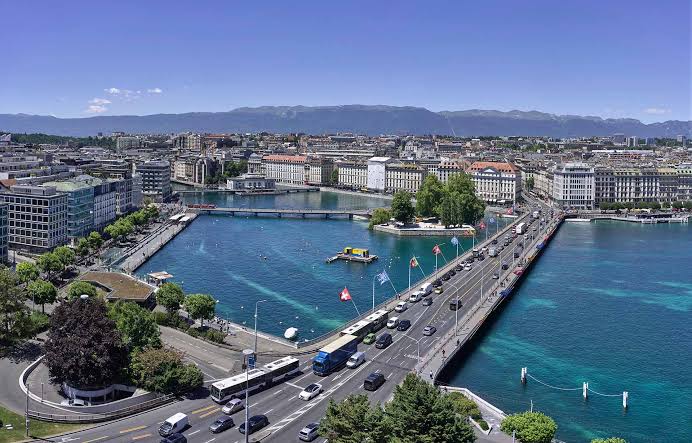
Geneva combines natural beauty with international influence and it charges a premium for both. Home to global organisations like the United Nations and the World Health Organization, the city attracts diplomats, expats, and high-income professionals. With demand like that, the cost of living doesn’t hold back.
Average Monthly Rent
- 1-bedroom in the city centre: $2,700 – $4,000
- 3-bedroom apartment: $4,800 – $6,500+
Housing is limited, and regulations make the rental market highly competitive. Many new arrivals wait months to secure a long-term lease.
What Drives the Cost
- International presence: Geneva caters to a global crowd, which keeps prices high across the board.
- Limited housing stock: Supply doesn’t meet demand, especially for family apartments and central locations.
- Dining out: A basic restaurant meal starts at $30–$40 per person.
- Groceries and services: Essentials like meat, dairy, and personal care items are among the highest-priced in Europe.
- Mandatory health insurance: Like Zurich, residents must buy private insurance, which can add significantly to monthly expenses.
Life in Geneva
It’s clean, calm, and deeply multicultural. Public transport is reliable, the scenery is stunning, and everything feels well-managed. But for newcomers, especially those without a strong income or expat package, the price of settling in can be overwhelming.
4. New York City, USA
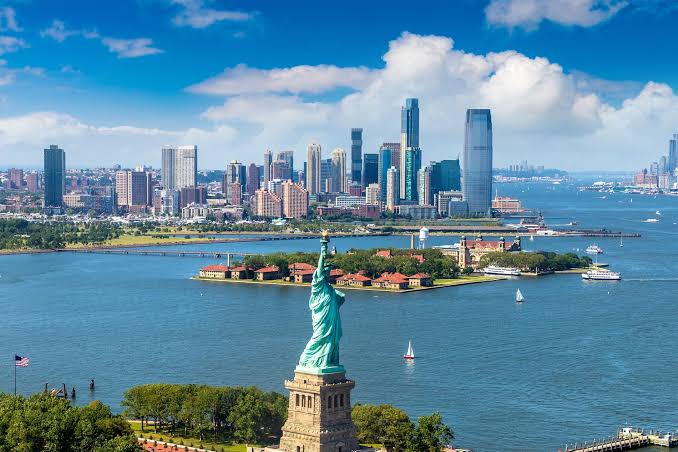
New York doesn’t need much introduction but it does need a big budget. It’s the most expensive city in the U.S. and regularly ranks among the costliest in the world. High demand, limited space, and a fast-paced lifestyle all push the cost of living into the stratosphere.
Average Monthly Rent
- 1-bedroom in Manhattan: $3,500 – $5,000
- 3-bedroom apartment: $6,000 – $9,000+
Even outer boroughs like Brooklyn and Queens aren’t far behind. Rent remains the single biggest burden for most residents.
What Drives the Cost
- Housing demand: NYC has more renters than homeowners, and competition is fierce — especially in desirable areas.
- Everyday essentials: Groceries, utilities, and household items all cost more here than the national average.
- Transport: The subway is affordable ($132/month unlimited pass), but car ownership is costly due to parking, insurance, and tolls.
- Lifestyle inflation: Dining out, entertainment, and personal services (like haircuts and gyms) often come with hefty price tags.
Life in New York City
You get access to everything including culture, business, fashion, food but you pay for it. Salaries can be high, especially in finance and tech, but so are taxes and living costs. For many, the city’s energy and opportunity make it worth every dollar.
5. Hong Kong

Hong Kong has long been known for its sky-high property prices, but it’s not just housing that hits hard. The city blends global finance with dense urban living and almost everything, from groceries to schooling, reflects that premium.
Average Monthly Rent
- 1-bedroom in city centre: $2,800 – $4,500
- 3-bedroom apartment: $6,000 – $8,000+
Space is a luxury here. Even compact apartments go for top dollar, especially in areas like Central, Wan Chai, and Mid-Levels.
What Drives the Cost
- Severe space constraints: There’s very little developable land, and that scarcity keeps real estate prices sky-high.
- Import reliance: Much of Hong Kong’s food and daily goods are imported, which pushes grocery bills up.
- Private education: Many expat families rely on international schools, which can cost $20,000–$40,000/year.
- Dining and services: Eating out is a cultural norm, but even casual meals add up fast. Personal care and services also tend to be pricey.
Life in Hong Kong
It’s fast-paced, efficient, and incredibly well-connected. Public transport is top-tier and relatively affordable. The city is safe and dynamic, but for many residents, especially those without housing benefits or corporate packages, the cost of space and daily living can be a real stretch.
6. Los Angeles, USA

Los Angeles might be laid-back in attitude, but its cost of living is anything but. Between sprawling real estate, car-dependent living, and high-end lifestyle culture, LA quietly racks up one of the highest living costs in the U.S.
Average Monthly Rent
- 1-bedroom in the city: $2,500 – $3,800
- 3-bedroom apartment: $4,800 – $7,000+
Desirable areas like Santa Monica, West Hollywood, and Beverly Hills demand a premium, with limited inventory and rising demand.
What Drives the Cost
- Housing demand and zoning laws: Low housing supply in prime neighborhoods has kept rent high for years.
- Car culture: Public transport exists but isn’t widely used. Between insurance, gas, parking, and car payments, transport adds a big chunk to monthly expenses.
- Healthcare and insurance: Private healthcare and high insurance premiums push costs up, especially for freelancers and self-employed residents.
- Everyday living: Groceries, dining, childcare, and fitness services all exceed national averages, sometimes by a lot.
Life in Los Angeles
It offers a lot — weather, diversity, career opportunities in entertainment and tech, and stunning nature. But living comfortably in LA means factoring in more than rent. You’ll feel the cost of simply existing here, especially if you’re aiming for anything close to a lifestyle upgrade.
7. Paris, France
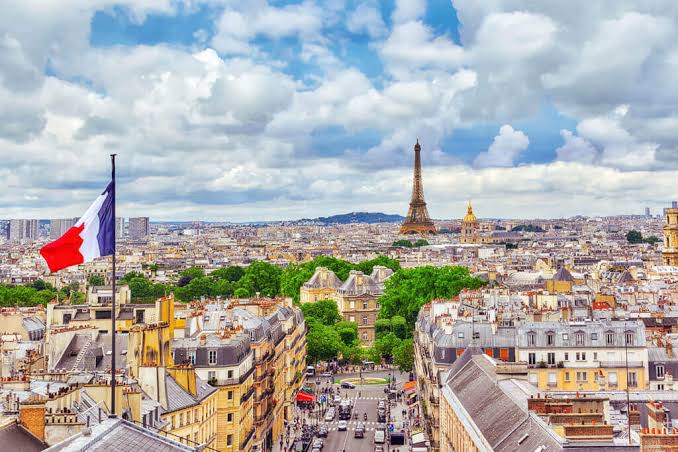
Paris is beautiful, historic, and culturally rich — but living here doesn’t come cheap. From tight apartments to high grocery bills, the French capital consistently ranks as one of the most expensive cities in Europe. And while the city delivers style and sophistication, it also demands a well-padded budget.
Average Monthly Rent
- 1-bedroom in the city centre: $2,200 – $3,500
- 3-bedroom apartment: $4,000 – $6,000+
Housing in central Paris is notoriously tight. Even older buildings without elevators or air conditioning go for premium prices if they’re located in desirable arrondissements.
What Drives the Cost
- Real estate scarcity: Paris has strict building height regulations and limited space, which keeps supply low and demand high.
- Daily essentials: Groceries, personal care, and transport are all priced higher than the national average.
- Dining culture: Eating out is part of Parisian life, but even casual meals at a brasserie can cost $25–$40 per person.
- Childcare and schooling: International schools and bilingual programs are especially pricey.
Life in Paris
You get charm, history, and global prestige — along with excellent public transport and world-class healthcare. But many locals still struggle with rent-to-income ratios, and newcomers are often shocked by just how far a euro doesn’t go.
8. Tel Aviv, Israel
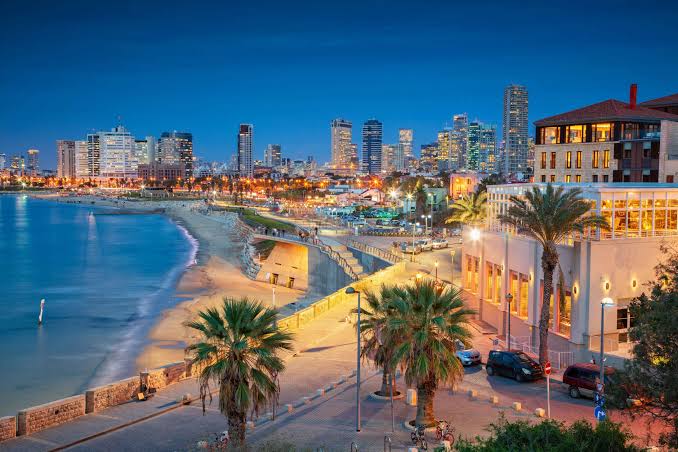
Tel Aviv is vibrant, sunny, and packed with innovation, but it’s also one of the most expensive cities to live in, not just in the Middle East but globally. With high-tech salaries driving up demand and limited land to build on, the cost of everything from housing to hummus is on the rise.
Average Monthly Rent
- 1-bedroom in city centre: $2,200 – $3,400
- 3-bedroom apartment: $4,000 – $6,000+
The city’s dense layout and coastal location limit housing availability, and expat-heavy areas come with especially high rents.
What Drives the Cost
- Strong tech economy: A booming startup and cybersecurity scene brings in high-income earners — and higher price tags.
- Housing shortages: Strict zoning laws and limited land push prices up fast.
- Cost of food and dining: Groceries are expensive (especially dairy, produce, and imported items), and dining out is common but costly — a simple café breakfast can run you $20–$30.
- Car ownership: With high taxes on vehicles and fuel, driving is an added expense many try to avoid.
Life in Tel Aviv
It’s lively, young, and culturally rich. You’ll find beaches, nightlife, and a strong sense of freedom. But you’ll also find yourself budgeting carefully because while the vibe is laid-back, the bills are anything but.
9. San Francisco, USA

San Francisco is where startups are born, IPOs are made, and rent prices defy logic. Fueled by Silicon Valley money and a severe housing crunch, the city remains one of the most expensive places to live — not just in the U.S., but globally.
Average Monthly Rent
- 1-bedroom in the city centre: $3,200 – $4,800
- 3-bedroom apartment: $5,500 – $8,000+
Even outside of downtown, rent barely lets up. Areas like Mission District, Noe Valley, and SoMa are in constant demand.
What Drives the Cost
- Tech wealth: High-paid tech professionals drive up demand across housing, services, and lifestyle.
- Housing shortage: Strict zoning, limited development, and long permitting processes have created a serious supply problem.
- Everyday basics: Groceries, dining, parking, and child care are all well above national averages.
- Tax and insurance: California state taxes and private healthcare costs pile on fast.
Life in San Francisco
You get innovation, diversity, and breathtaking views along with top-tier food, culture, and weather. But it’s not an easy city to “just get by” in. Most residents spend a major chunk of their income on housing alone. If you’re not in tech, the squeeze is real.
10. Copenhagen, Denmark
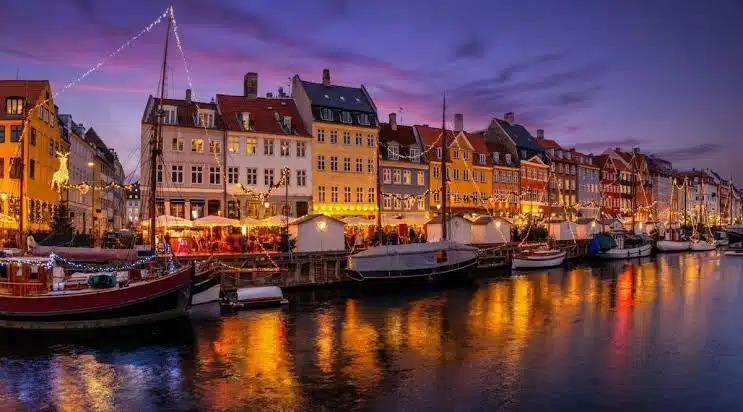
Copenhagen blends Scandinavian charm with modern minimalism, but don’t let the calm streets and cozy cafés fool you. Living here comes with a high price tag, especially when it comes to rent, dining out, and lifestyle services. It’s beautiful, safe, and efficient, but far from budget-friendly.
Average Monthly Rent
- 1-bedroom in the city centre: $2,200 – $3,500
- 3-bedroom apartment: $4,000 – $5,800+
Rent control exists, but high demand (especially from expats and students) keeps the market competitive and prices elevated.
What Drives the Cost
- High taxes, high services: Income taxes are steep — up to 55%, but they fund strong public services like healthcare, transport, and education.
- Dining and groceries: A casual meal out can cost $25–$40 per person. Alcohol is heavily taxed, and groceries, especially meat and produce, cost more than most European cities.
- Transport and cycling culture: Public transport is clean and efficient, but pricey. Many residents cycle, but owning a car here isn’t cheap.
- General lifestyle: Personal care, furniture, home goods, all beautifully designed, all expensive.
Life in Copenhagen
It’s one of the safest, most liveable cities in the world. You get clean air, beautiful parks, reliable infrastructure, and an excellent work-life balance. But to live comfortably and keep enjoying the hygge lifestyle, your income needs to keep up.
11. London, UK

London is dynamic, historic, and endlessly global. It’s a city of opportunity but also of eye-watering expenses. With strong demand across housing, transport, and private services, it consistently ranks among the priciest cities to live in worldwide.
Average Monthly Rent
- 1-bedroom in central London: £2,000 – £3,200 (~$2,500 – $4,000)
- 3-bedroom apartment: £4,000 – £6,500+
Whether it’s Kensington, Shoreditch, or even a Zone 2 flat, rent eats up a large portion of most residents’ income.
What Drives the Cost
- Housing shortage: London has long struggled with limited supply and high demand, especially in well-connected areas.
- Transport: The Tube is efficient but expensive. A monthly zone 1–2 travelcard costs around £160 (~$200).
- Groceries and dining: Groceries are moderate, but eating out, especially in trendy neighbourhoods, can easily run £25–£40 per person.
- Childcare and education: Private schools and nurseries are among the most expensive in Europe.
Life in London
There’s always something to do — art, food, events, business, and culture. Public services like the NHS ease healthcare costs, but most expats and higher-income earners still face big monthly outflows. To live comfortably here, you’ll either need a solid income or sharp budgeting skills — ideally both.
12. Seoul, South Korea

Seoul is futuristic, stylish, and full of energy. It’s one of Asia’s most tech-driven cities, offering excellent infrastructure, a booming pop culture scene, and high standards of living. But beneath all the neon lights and convenience lies a growing affordability challenge, especially for housing.
Average Monthly Rent
- 1-bedroom in city centre: ₩1.5M – ₩2.5M (~$1,100 – $1,900)
- 3-bedroom apartment: ₩3.5M – ₩5.5M+ (~$2,600 – $4,100+).
What’s unique here is the jeonse system, a lump-sum rental deposit that can range from $100,000 to $500,000, letting tenants live rent-free for 2 years. But not everyone can afford that upfront.
What Drives the Cost
- Rising real estate prices: While not as extreme as Hong Kong or NYC, Seoul’s housing market has surged in recent years.
- Education obsession: Private tutoring and cram schools (hagwons) are a major expense for families, easily $500–$1,500/month per child.
- Imported goods: While Korean cuisine is affordable, foreign food and products are costly.
- Lifestyle inflation: Beauty, fashion, and tech are big spending areas and the pressure to keep up is real.
Life in Seoul
It’s modern, efficient, and buzzing 24/7. Public transport is top-notch, and healthcare is surprisingly affordable. Still, for residents chasing a modern lifestyle, costs pile up quickly. If you’re not budgeting, Seoul will definitely remind you.
13. Oslo, Norway
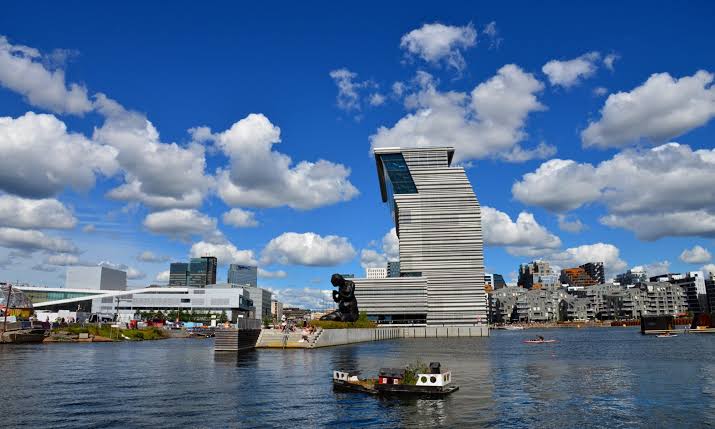
Oslo is peaceful, clean, and surrounded by nature but living here means adjusting to some of the highest prices in Europe. Norway’s strong economy, high wages, and social benefits come with equally strong consumer prices. The city offers quality, but not without a cost.
Average Monthly Rent
- 1-bedroom in city centre: NOK 14,000 – 20,000 (~$1,300 – $1,900)
- 3-bedroom apartment: NOK 25,000 – 35,000+ (~$2,300 – $3,200+).
While not as steep as London or NYC, rent is far from cheap, especially in central neighbourhoods like Frogner and Grünerløkka.
What Drives the Cost
- High taxes, high services: Norway has a strong welfare state funded by high taxes and that reflects in pricing across the board.
- Labour costs: Services like dining out, repairs, and childcare cost more because workers are well-paid.
- Groceries and alcohol: Food prices are elevated, and alcohol is heavily taxed. A bottle of wine can easily cost $20–$30.
- Car ownership: Fuel, tolls, and taxes make driving expensive. Most locals stick to public transport.
Life in Oslo
Healthcare and education are publicly funded and excellent. Public transport is clean and reliable. And the quality of life, with fresh air, safety, and beautiful surroundings is a huge draw. But unless you’re earning Norwegian wages, you’ll definitely feel the squeeze.
14. Sydney, Australia

Sydney offers a postcard-perfect lifestyle — coastal views, cosmopolitan energy, and world-class amenities. But behind the sunshine is one of the most expensive housing markets in the world. Whether you’re renting or owning, Sydney asks for a big financial commitment.
Average Monthly Rent
- 1-bedroom in city centre: AUD $2,800 – $3,900 (~$1,850 – $2,600 USD)
- 3-bedroom apartment: AUD $4,800 – $6,500+ (~$3,200 – $4,300 USD).
Rent in Sydney is consistently high, especially in areas like Surry Hills, Bondi, or the CBD.
What Drives the Cost
- Sky-high housing demand: Limited land, strong investment activity, and growing population keep prices elevated.
- Transport and fuel: Owning a car is pricey with toll roads, parking, and fuel costs. Public transport is decent but adds up.
- Groceries and dining: Local produce is good quality, but food (especially eating out) is expensive. A casual lunch can cost AUD $20–$30 (~$13–$20 USD).
- Private healthcare: While there’s public Medicare, many residents also take on private insurance, adding to monthly expenses.
Life in Sydney
It’s clean, safe, and filled with natural beauty — beaches, parks, and a relaxed vibe. Salaries are relatively high, and the lifestyle is attractive, but Sydney definitely isn’t forgiving if you’re on a tight budget. The sun is free — but most other things aren’t.
15. Tokyo, Japan

Tokyo is massive, modern, and incredibly efficient — and while it’s one of the world’s most developed cities, its cost of living is surprisingly balanced for locals. For outsiders though, especially expats looking for space and Western comforts, the expenses start to climb.
Average Monthly Rent
- 1-bedroom in city centre: ¥200,000 – ¥300,000 (~$1,300 – $2,000)
- 3-bedroom apartment: ¥400,000 – ¥600,000+ (~$2,700 – $4,100+).
Compared to other global cities, Tokyo offers relatively affordable housing — but space is tight, and location makes a huge difference.
What Drives the Cost
- Space and location: Land is limited, and living close to the city’s core (Minato, Shibuya, Chiyoda) costs much more.
- Schooling for expats: International schools can cost $20,000–$30,000/year, making education a major expense for non-Japanese families.
- Imported goods: While local food is affordable, imported items (cheese, wine, skincare, etc.) are expensive.
- Utilities and service costs: Air conditioning, water, and seasonal energy spikes push monthly bills up, especially in summer and winter.
Life in Tokyo
The city is clean, safe, and incredibly well-run. Public transport is world-class and reasonably priced. Healthcare is affordable and excellent. And the food scene? Legendary. If you’re content with modest space and a mix of local living, Tokyo is more manageable than its reputation suggests. But expat-style living will still stretch your budget.
16. Shanghai, China

Shanghai is China’s financial capital, fast-paced, globally connected, and constantly evolving. With its luxury malls, skyline views, and thriving expat communities, it’s no surprise that Shanghai is one of Asia’s most expensive cities. While some costs are manageable, others, especially housing, are steep.
Average Monthly Rent
- 1-bedroom in central areas: ¥12,000 – ¥20,000 (~$1,600 – $2,800)
- 3-bedroom apartment: ¥25,000 – ¥40,000+ (~$3,500 – $5,600+).
Popular neighbourhoods for expats like Jing’an, Xuhui, or the Former French Concession come with some of the city’s highest rents.
What Drives the Cost
- Premium expat housing: Local housing may be cheaper, but many expats go for modern, international-standard apartments and those come at a price.
- Education: International schools charge $25,000–$45,000/year, often making it one of the biggest expenses for families.
- Imported food and goods: Western brands and groceries are significantly marked up.
- Lifestyle inflation: Shanghai has no shortage of fine dining, spas, gyms, and shopping but indulging regularly adds up fast.
Life in Shanghai
Public transport is affordable and efficient. Healthcare is decent, but private options (preferred by expats) are expensive. If you embrace local living, Shanghai can be more affordable than cities like Hong Kong or Singapore. But if you’re recreating a Western lifestyle, the costs won’t cut you much slack.
17. Vienna, Austria
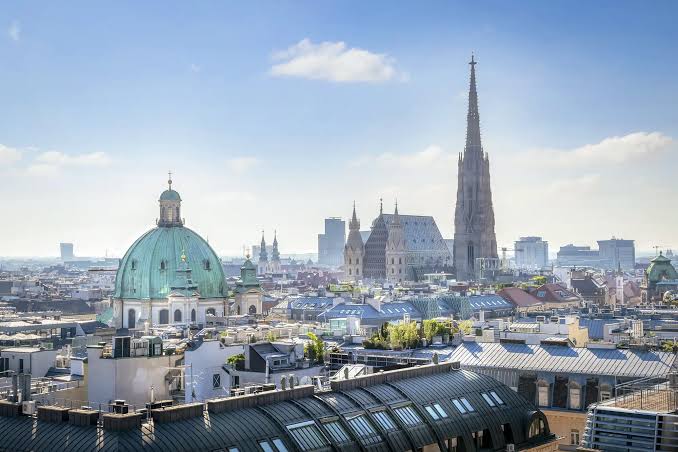
Vienna is often ranked one of the most liveable cities in the world but it’s not outrageously expensive. While it’s not cheap, especially for foreigners used to larger spaces or international schools, Vienna offers exceptional value for the quality of life it delivers.
Average Monthly Rent
- 1-bedroom in the city centre: €1,200 – €1,800 (~$1,300 – $2,000)
- 3-bedroom apartment: €2,500 – €3,800+ (~$2,700 – $4,100+). Vienna’s rent prices are moderate compared to cities like Zurich or London, especially considering what you get in return.
What Drives the Cost
- Public services: Healthcare, education, and public transport are heavily subsidised. The costs are low, but taxes are high.
- Day-to-day expenses: Groceries and transport are fairly priced. Dining out is reasonable, a good meal might cost €15–€25 per person.
- International schooling: If you go the private route, this is where the costs spike. So, expect €20,000–€30,000/year.
- Leisure and culture: Concerts, museums, and events are everywhere, and many are either free or affordable.
Life in Vienna
It’s clean, calm, and deeply cultured. Public transport is cheap and reliable. Healthcare is excellent. You get parks, history, and a rich social safety net. For what you pay, Vienna might just be one of the best deals on this entire list if you don’t insist on luxury everything.
18. Dubai, UAE

Dubai is glamorous, futuristic, and always doing the most. Skyscrapers, designer malls, five-star everything, this desert metropolis loves to dazzle. But while there’s no personal income tax, the cost of living well here adds up fast.
Average Monthly Rent
- 1-bedroom in city centre (Downtown/Marina): AED 8,000 – 13,000 (~$2,200 – $3,500)
- 3-bedroom apartment: AED 18,000 – 30,000+ (~$4,900 – $8,200+).
Prices vary massively depending on where you stay. Jumeirah, Business Bay, and Palm Jumeirah are on the higher end.
What Drives the Cost
- Luxury lifestyle pressure: From cars to clothes to brunches, the social scene leans premium and the culture subtly pushes you to keep up.
- Schooling: International schools are common and pricey. It’s within AED 40,000–100,000/year (~$11,000–$27,000).
- Housing inflation: Rent is back on the rise post-pandemic, especially in sought-after areas.
- Transport and utilities: Petrol is cheap, but car ownership, AC-heavy utility bills, and parking fees all add up.
Life in Dubai
It’s tax-free, safe, sunny, and buzzing with opportunity. You’ll find everything from Michelin-starred restaurants to desert camps. But the “Dubai dream” costs money, especially if you’re not careful. You can live modestly here, yes but most people don’t.
19. Amsterdam, Netherlands
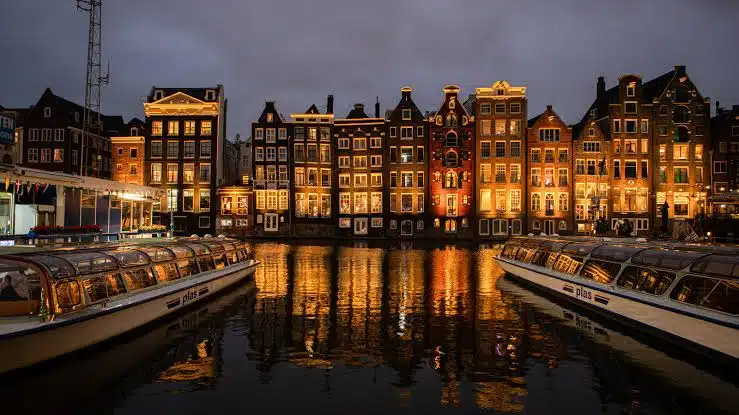
Amsterdam has charm in every direction, canals, cobbled streets, quirky cafés, and a famously relaxed lifestyle. But don’t let the chilled-out vibe fool you. The cost of living here has surged in recent years, especially when it comes to rent and daily expenses.
Average Monthly Rent
- 1-bedroom in city centre: €1,800 – €2,600 (~$1,950 – $2,800)
- 3-bedroom apartment: €3,500 – €5,000+ (~$3,800 – $5,400+)
Housing is tight, especially for newcomers. Even tiny apartments in less-central areas come at a premium.
What Drives the Cost
- Housing shortage: There’s strong demand but limited space. Rental prices are high, and finding available flats takes time (and luck).
- Utilities and energy: Monthly utility bills can spike, especially in colder months.
- Dining and groceries: Groceries are manageable, but eating out? A basic dinner at a mid-range spot can run €25–€40 per person.
- Tourism impact: As a top travel destination, prices on everything from coffee to clothes are affected by the constant tourist flow.
Life in Amsterdam
It’s scenic, safe, and built for balance. Biking is the norm, healthcare is reliable, and the city is full of cultural gems. You’ll likely spend more than expected but the quality of life, especially if you embrace a local pace, makes it feel worth it.
20. Milan, Italy
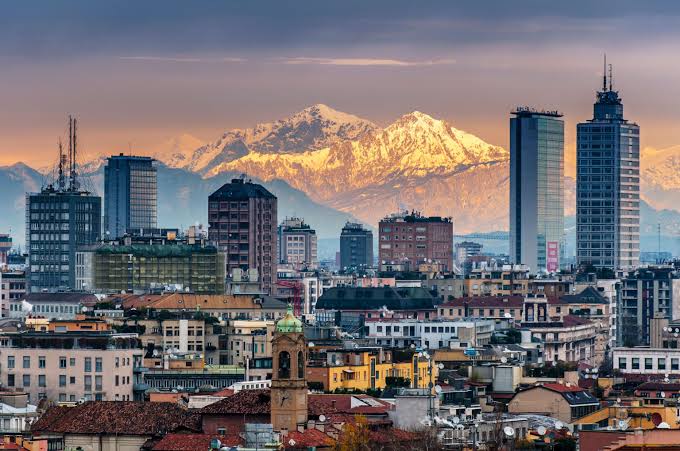
Milan is Italy’s fashion capital, a business hub, and a magnet for style, culture, and cosmopolitan living. While it’s not quite as expensive as Zurich or London, Milan ranks as one of the priciest cities in Southern Europe especially for anyone seeking comfort and convenience in central zones.
Average Monthly Rent
- 1-bedroom in city centre: €1,500 – €2,300 (~$1,600 – $2,500)
- 3-bedroom apartment: €3,000 – €4,500+ (~$3,200 – $4,800+)
Brera, Porta Venezia, and Navigli come with charm and a serious price tag. The farther from the centre, the more affordable things get.
What Drives the Cost
- Housing demand: Milan’s role as a business and fashion centre creates constant demand for well-located apartments.
- Private schooling: International schools run around €15,000–€25,000/year, adding weight for expat families.
- Dining and lifestyle: You’ll find affordable pasta, yes, but fine dining, cocktails, and chic cafés add up fast.
- Public transport & car use: The metro is reliable and relatively cheap, but many residents still drive and that comes with insurance, fuel, and limited parking.
Life in Milan
It’s stylish, well-connected, and full of culture. You can enjoy art, architecture, aperitivos, and designer shopping, but Milan is more business-like than touristy Rome or laid-back Florence. The city moves fast, and so does your money. Still, if you love a polished lifestyle with a touch of Italian drama, Milan delivers.
Final Thoughts: The Cost of Comfort, Status, and a View
From Zurich’s polished perfection to Dubai’s over-the-top luxury, one thing is clear: living in a top-tier city comes at a serious cost. These places offer world-class services, safety, infrastructure, and career opportunities. But they also test your budgeting skills like never before.
For many, the dream of living in a global city is tied to ambition. You want the connections, the culture, the convenience.
But it’s also okay to pause and ask: is it worth it for me?
Because behind every skyscraper and designer store is a daily reality that often involves high rent, long commutes, and a cost of living that can drain even a good salary.
That said, if you plan smart, earn well, or get a little lucky, living in any of these cities can be a rewarding adventure. The key is to know what you’re signing up for and what you’re willing to trade for it.
So, out of all 20 cities…Which one stole your heart and which one scared your bank app into hiding? Let me know in the comments!

